stripers
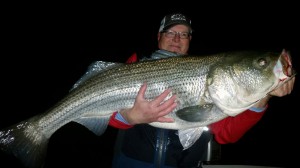 “It’s the worst winter ever.” Those words might sound surprising coming from Jamie Clough, a fisherman who has caught more forty-inch-plus rockfish in the last three months than most people will catch in a lifetime, but he’s right. It’s been tough. I’m on record for predicting that 2016 will be the best year in recent history for light-tackle striper casting on the Chesapeake Bay. I’m not taking it back, but after the first three months, I feel like I have some explaining to do.
“It’s the worst winter ever.” Those words might sound surprising coming from Jamie Clough, a fisherman who has caught more forty-inch-plus rockfish in the last three months than most people will catch in a lifetime, but he’s right. It’s been tough. I’m on record for predicting that 2016 will be the best year in recent history for light-tackle striper casting on the Chesapeake Bay. I’m not taking it back, but after the first three months, I feel like I have some explaining to do.
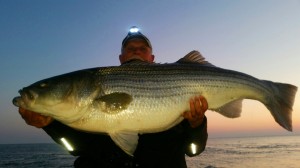 In past years, January, February, and March have been wide-open for fishing in the warm water discharges of the Patapsco and Potomac Rivers and around the power plants of the Mid-Bay. In February 2014, my fishing partners and I enjoyed the best day I’ve ever heard of, going forty over forty. Yes, that’s forty huge stripers over forty-inches long, all caught in one morning. The fishing was so good we were trying to glue two ten-inch Bass Kandy Delights together so we could pull out the biggest of the big fish. In years like that, you can make a lot of mistakes and still catch fish. While I’ve seen some good days since then, nothing like that happened this year. To catch big fish this winter, we had to pull out all the stops. Read More!
In past years, January, February, and March have been wide-open for fishing in the warm water discharges of the Patapsco and Potomac Rivers and around the power plants of the Mid-Bay. In February 2014, my fishing partners and I enjoyed the best day I’ve ever heard of, going forty over forty. Yes, that’s forty huge stripers over forty-inches long, all caught in one morning. The fishing was so good we were trying to glue two ten-inch Bass Kandy Delights together so we could pull out the biggest of the big fish. In years like that, you can make a lot of mistakes and still catch fish. While I’ve seen some good days since then, nothing like that happened this year. To catch big fish this winter, we had to pull out all the stops. Read More!
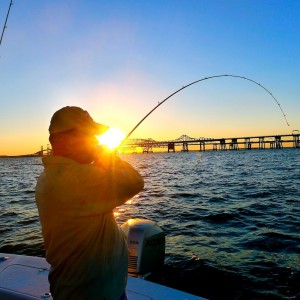 When it comes to selecting a rod, light tackle fishermen are rightfully very picky. Most of us get very specific about what we like. You’ll find several websites that have great information about choosing a multi-purpose fishing rod, but I don’t know of many that focus specifically on the best rods for casting lures on the Chesapeake Bay. There is always an element of personal choice when it comes to rod selection, and less experienced anglers should use basic and less-expensive equipment, but if you’re serious about the light tackle game, here are six things (and maybe a few more) you need to know:
When it comes to selecting a rod, light tackle fishermen are rightfully very picky. Most of us get very specific about what we like. You’ll find several websites that have great information about choosing a multi-purpose fishing rod, but I don’t know of many that focus specifically on the best rods for casting lures on the Chesapeake Bay. There is always an element of personal choice when it comes to rod selection, and less experienced anglers should use basic and less-expensive equipment, but if you’re serious about the light tackle game, here are six things (and maybe a few more) you need to know:
1. Baitcasting Benefits – Once you see a baitcaster used effectively for catching stripers, you’ll never go back to a spinning outfit. Baitcasters are appropriate for most jigging situations in the Chesapeake Bay. Wind and current can make a boat drift rapidly across a good jigging spot. As you drift across and away from the fish, your lure will be pulled up, over and above the strike zone. With a baitcaster, you simply press the thumb bar to let your lure fall back down to the proper depth. Unlike with a spinning reel, you don’t have to cast again. Keep in mind that, through most of the year, the bigger stripers are usually close to the bottom, so you increase your chances of catching them by keeping the lure where they are. Here’s a link to a video I shot in July a few years ago at the Bay Bridge. It shows some useful baitcasting techniques and includes some shots of resetting a lure into the strike zone. https://www.youtube.com/watch?v=sH_3rC0sZ-Y
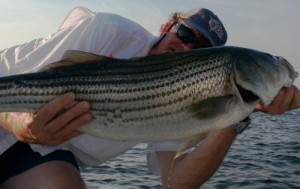 To share time-sensitive fishing information and relay real-time conditions on the water, I’ll be more active on Twitter. Last night at about 4:00 PM, I mentioned via Facebook that I would live-tweet a fishing trip starting at 5:30 PM. I’ll do this more often. Be assured that I won’t mention too many locations, but I’ll be specific about the patterns and techniques we encounter. I’ll also tweet pictures of the fish we’re catching, provide sonar shots, and share thoughts and details about hot lures and techniques. If you missed last night’s feed, you can read it on my Twitter page – @shawnkimbro. You can also follow me there to get the info live as it happens. I can’t do this all the time, but I’ll re-post last nights feed here, with some additional details and commentary inserted in italics. I’ve also cleaned up spelling and grammar since I use Google Voice instead of trying to type on my android touch-screen with wet hands. All the pictures (click the Twitter links) including the one to the left were tweeted live from the water.
To share time-sensitive fishing information and relay real-time conditions on the water, I’ll be more active on Twitter. Last night at about 4:00 PM, I mentioned via Facebook that I would live-tweet a fishing trip starting at 5:30 PM. I’ll do this more often. Be assured that I won’t mention too many locations, but I’ll be specific about the patterns and techniques we encounter. I’ll also tweet pictures of the fish we’re catching, provide sonar shots, and share thoughts and details about hot lures and techniques. If you missed last night’s feed, you can read it on my Twitter page – @shawnkimbro. You can also follow me there to get the info live as it happens. I can’t do this all the time, but I’ll re-post last nights feed here, with some additional details and commentary inserted in italics. I’ve also cleaned up spelling and grammar since I use Google Voice instead of trying to type on my android touch-screen with wet hands. All the pictures (click the Twitter links) including the one to the left were tweeted live from the water.
 Shawn Kimbro
Shawn Kimbro @ShawnKimbro 19h
Tweeting details of tonight’s fishing trip beginning 5:30 pm. #stormdodging
*I actually started a little earlier with a few preliminary details.
![0321120733a[1]](http://www.chesapeakelighttackle.com/wp-content/uploads/2012/04/0321120733a1-300x225.jpg) “I only write when I’m inspired,” wrote William Faulkner. I’d find that statement comforting if he hadn’t followed it with, “and I’m inspired every morning at 9:00 AM.” Lately, my every-morning-at-9:00 AM-ritual hasn’t included much writing. Oh, I’ve had plenty to write about, it’s just that I’ve over-committed myself (again) so that every spare waking minute seems filled with obligation. When I have a spare hour, I usually go fishing. Since I bet you’d much rather hear about the fishing than the excuses, I’ll dive right in.
“I only write when I’m inspired,” wrote William Faulkner. I’d find that statement comforting if he hadn’t followed it with, “and I’m inspired every morning at 9:00 AM.” Lately, my every-morning-at-9:00 AM-ritual hasn’t included much writing. Oh, I’ve had plenty to write about, it’s just that I’ve over-committed myself (again) so that every spare waking minute seems filled with obligation. When I have a spare hour, I usually go fishing. Since I bet you’d much rather hear about the fishing than the excuses, I’ll dive right in.
There’s nothing more inspiring than a big fish. That’s Uncle Phill Anderson in the cover shot holding up a nice light-tackle fish he jigged up on a recent foggy morning in the mid-Bay. (Shhh, don’t tell the meat-fleet we’re picking off fish of this class with light tackle. It might catch on!) When I left off a month ago, I was smack in the middle of a series about strike triggers. I’m discussing why striped bass attack a lure, and how they are attracted to their prey. As previously mentioned, almost any lure or technique will work on hunger-feeding fish. Unfortunately, most of us don’t have the time or resources to always go fishing at the places where hungry fish are most abundant. We have to fish in the limited time we have available, and usually very close to home. While we may occasionally encounter groups of ravenous fish, most of the stripers in our neighborhoods are pretty hard to catch. In order to be consistently successful, we have to provoke strikes from fish that may not be inclined to bite by appealing to their five senses. I’ve written about sight, sound, and feel. This entry completes the strike triggers series with a look at smell and taste. Read More!
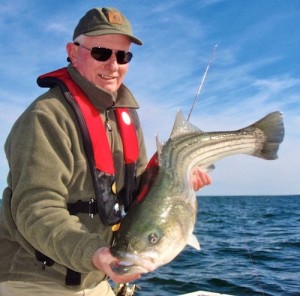 Last December, I caught up with my friend Gaylon Thompson at one of my light tackle seminars in Severna Park, Maryland. During the few minutes we had to talk, we wondered if we might be able to get in a fishing trip in early 2012. I was very excited when Rich Jenkins called me last week to say he and Gaylon were heading down to Virginia to fish in the ocean Monday, and I was invited. He also invited Jamie Clough. We’ve been hearing about the coastline bite for a while now from Wild Bill and other fishermen who follow the migration. Even though I’m turning up a few hard-to-catch but very big fish here in the Bay, we couldn’t resist giving it a go. Our first challenge was deciding whether to fish the Chesapeake Bay Bridge Tunnel, or the ocean. We called, emailed, and Facebooked everyone we could think of seeking advice. Some of our friends came though, especially “Hillbilly Boater” Jack, and a couple of Jamie’s buddies. I also got some good info from some of Tattoo Charlie’s buds on Facebook. Read More!
Last December, I caught up with my friend Gaylon Thompson at one of my light tackle seminars in Severna Park, Maryland. During the few minutes we had to talk, we wondered if we might be able to get in a fishing trip in early 2012. I was very excited when Rich Jenkins called me last week to say he and Gaylon were heading down to Virginia to fish in the ocean Monday, and I was invited. He also invited Jamie Clough. We’ve been hearing about the coastline bite for a while now from Wild Bill and other fishermen who follow the migration. Even though I’m turning up a few hard-to-catch but very big fish here in the Bay, we couldn’t resist giving it a go. Our first challenge was deciding whether to fish the Chesapeake Bay Bridge Tunnel, or the ocean. We called, emailed, and Facebooked everyone we could think of seeking advice. Some of our friends came though, especially “Hillbilly Boater” Jack, and a couple of Jamie’s buddies. I also got some good info from some of Tattoo Charlie’s buds on Facebook. Read More!


